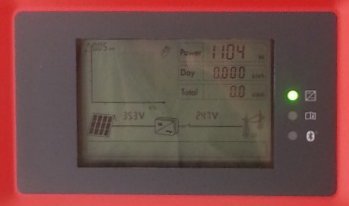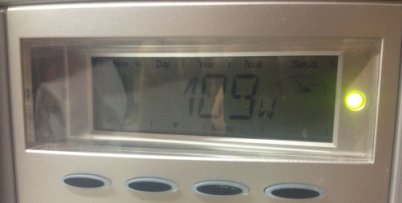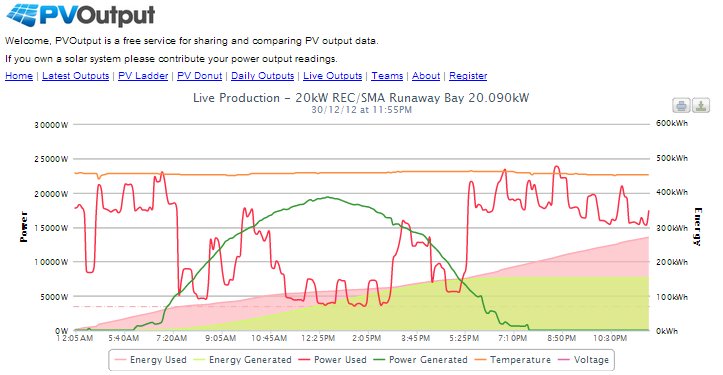Solar Power Monitoring

Solar power monitoring is crucial. Many people on the Gold Coast have solar power systems installed and they look forward to large savings on their power bill but unfortunately quite a number of people leave the monitoring of their solar power system to their power bill. This is fine if the solar power system is functioning correctly, but what if a problem has developed at the beginning of the quarter and you are waiting for your power bill to find out about it?
When that power bill finally does arrive you are going to get a rude shock! Unfortunately this is an all too common occurrence with solar power system owners, usually we find that people are vigilant in monitoring the operation of their solar power system for the first few months after it is installed but after that they become complacent about it.
Solar Power Monitoring: Monitoring Your Solar Power Inverter
A few seconds a week is all it takes to check the correct operation of your solar power system. The following is a list of generic read outs from solar power inverters; understanding what they mean will help you to quickly ensure that your solar power system is working correctly.

Coloured lights: Next to every grid connect solar power inverter on the market will have one or more LED’s to tell you with a quick glance what your solar power system is doing. the following is a description of the most common LED displays-please note your solar power inverter may be slightly different, please check your inverter manual for further information.
No lights: Most solar power inverters at night time or when there is no power from the solar panels will be completely blank – if you are looking at your inverter during the day and there are no lights illuminated this would usually mean that no DC power is getting from the solar panels to the inverter. Check the PV array DC isolator switches are turned on beside the inverter and on the roof (only if you are competent and an isolator switch is actually installed on the roof) and check that the solar panels are in sunlight, if this does not get your inverter operational please contact your solar power system installer.
Green light on constant: this is what you always should see during the day. This green light very quickly tells you that power is coming from the solar panels, power is available from the electricity grid and the inverter is currently converting the solar power into useable electricity to power your home!
Green light flashing: usually this means the inverter is in a start up procedure, the light should stop flashing within a couple of minutes and go constant if the inverter is functioning correctly.
Red light: red lights on solar power inverters usually are a warning light that a fault is present. More information in regards to the fault should be visible on the display.
Orange light: usually signifies a warning or information – more information should be visible on the display.
All lights on: this usually happens in a startup procedure as part of a self test function. This will always happen first thing in the morning as the inverter starts up and also at the end of the day as the solar panels are running out of light and are no longer supplying the inverter with enough power to start it up fully. The inverter will continue trying to startup until the solar panels run out of light completely.
Basic inverter readouts

Pac: Power being outputted in AC by the inverter right now in Watts. The power being outputted in AC will be constantly changing during the day, starting off at a few Watts in the morning and peaking around lunch time if it is a clear day on a North facing system.
E-today: Total of energy that has been produced since the inverter first started up in the morning. Displayed in either Wh or kWh. This is the best reading to note to ascertain whether your solar power system is working correctly. For more information on what you can expect this readout to be at the end of the day please check out: How many solar kWh per day can I expect?
E-total: Total of energy produced since the inverter was first installed. In kWh or MWh.
h-total: Hours total the inverter has been operational for since first installed.
Solar Power Monitoring: On the Computer or over the Internet
Many solar power inverters support the connection of an RS485 or RS232 data cable to the inverter that can take the data from the inverter and display it on a computer usually via an RS485 or RS232 to USB adaptor. Some inverters even support WIFI or Bluetooth for wireless data connections to your inverter.
A great way to setup a solar power monitoring system is with a Current Cost energy monitoring system. This system uses current transformers (CT’s) that clip over the AC active cable from the inverter and can also be used to monitor the AC power that your property is consuming at the same time if a second CT is used. The data collected from your monitor can be sent straight to the internet so you can monitor your solar power system from anywhere in the world! With websites such as PVOutput.org the following can be achieved:
Click on the above image to view the latest solar power monitoring output for this solar power system on PVOutput
Conclusion
In conclusion however you choose to monitor your solar power system is fine, the key is to ensure you do just that – monitor it regularly! That way if for some reason your solar power system stops functioning you can get it operational again and working for you ASAP!


